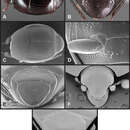Description
provided by Zookeys
Length: 1.75–2.37 mm, width: 1.68–2.12 mm; body rufopiceous, strongly rounded, convex; frons broad, slightly depressed in middle; frontal stria just turning inward between eyes, absent from middle; labrum less than twice as wide as long, weakly emarginate apically; left mandible untoothed, right with small, subacute basal tooth; pronotal disk with prescutellar impression weak, with very fine prescutellar fovea in some individuals, ground punctation fine and inconspicuous, with ~10 coarser lateral punctures; marginal pronotal stria broadly interrupted behind head; submarginal pronotal stria continuous across front and sides, rarely abbreviated or fragmented at sides; median pronotal gland openings about two-thirds pronotal length behind anterior margin; elytra with two complete epipleural striae, outer and inner subhumeral striae absent, striae 1-2 complete, 3rd stria present in basal third and apical one-sixth, rarely complete, 4th and 5th striae present as apical rudiments, sutural stria present in apical four-fifths; apical elytral stria absent; prosternal keel broad, flat, weakly emarginate at base, carinal striae well-separated at base, sinuate, joined anteriorly in broad arch; prosternal lobe short; mesoventrite short, wide, weakly projecting anteriorly, marginal stria narrowly interrupted at middle; mesometaventral stria arched forward to middle of mesoventrite, sinuate at sides; lateral metaventral stria extending toward outer third of metacoxa, slightly abbreviated at apex; 1st abdominal ventrite with complete inner lateral stria, abbreviated outer lateral stria, with fine postmetacoxal fovea between them; propygidium and pygidium with dense, fine, shallow ground punctation; propygidium with coarse basomedial punctures, sparser laterally and posteriorly; pygidium lacking any interspersed coarse punctures; apical marginal stria absent. Male genitalia (Figs 77A, C, E, H): accessory sclerites absent; T8 short, sides subparallel in basal two-thirds, arcuately convergent to apex, apical emargination shallow, basal emargination deep, rather narrow, intersecting basal membrane attachment line, ventrolateral apodemes subacute medially, not meeting at midline; S8 with halves well separated, sides weakly divergent to blunt apices, apical guides widened from base to apex; T9 with sides parallel in basal two-thirds, convergent to narrow apices; T10 with halves separate; S9 narrow, sides subparallel, base narrowly emarginate, apex with very fine median emargination, apical flange interrupted; tegmen very narrow, somewhat sinuate in lateral view, medioventral process narrowly ‘V’-shaped, weakly projecting beneath about one-fourth from base; median lobe thin, about two-thirds tegmen length, with proximal apodemes differentiated, proximal one-fourth filamentous; basal piece about one-third tegmen length.
- license
- cc-by-3.0
- copyright
- Michael S. Caterino, Alexey K. Tishechkin
- bibliographic citation
- Caterino M, Tishechkin A (2013) A systematic revision of Operclipygus Marseul (Coleoptera, Histeridae, Exosternini) ZooKeys 271: 1–401
- author
- Michael S. Caterino
- author
- Alexey K. Tishechkin

